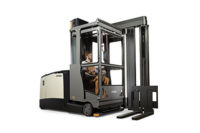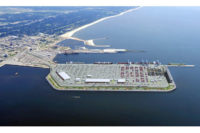It’s no secret that automation and technology advancements have changed the way we eat, think, feel and carry on with even the most mundane day-to-day activities. Shoppers can build a grocery list with the touch of a button. Chefs can fulfill orders in a flash. And, consumers can look up and purchase just about any product or service through their cell phone.
Now, such enhancements are changing the way operators move product through their supply chain. That’s because today’s logistics software providers offer apps for even the most complex supply chains.
When it comes to managing transportation operations, every second counts, says Andy Miller, regional sales manager for TMW Systems, Inc., Beachwood, Ohio.
“We designed our routing solution to serve the needs of people that are actually building and managing the routes, but we also recognize the importance of a positive driver experience in a successful software implementation,” Miller says. “Whether it is completing a Driver Vehicle Inspection Report, providing turn-by-turn navigation or delivering visibility to stop levels details with customer-specific requirements, we put the right tools in the hands of drivers.”
TMW Systems implemented a series of enhancements to its routing and dispatching solutions that include multiple functions tied into one platform, an increase in driver communication features, line level over, short or damage (OS&D) capabilities, signature capture and pictures taken at POD that automatically attach to the order, Miller adds.
“Software usability is always a concern for businesses these days, when rapid on-boarding of new users and the quick adoption of new technology are so critical to gaining return-on-investment on a software investment,” says Miller.
JDA Software, Scottsdale, Ariz., also carried out enhancements to its supply chain and logistics software. The JDA Transportation & Logistics Management, part of the JDAeight solution set, now enables operators to leverage actionable data, which in turn increases employee performance, optimally balance capacity and bookings for global logistics moves and remove silos in localized routing.
“JDA Transportation & Logistics Management supports rating and scheduling of both direct-to-door and port-to-port rates,” says Fabrizio Brasca, vice president of global logistics. “Bookings can be rated and rate shopped and support full ability to adjust sailings, equipment types and carriers alongside adding and removing containers on the booking.”
In May, HighJump Software launched HighJump Supply Chain Advantage Suite 12.0, the latest version of its supply chain management software.
“HighJump’s distributed order management system provides our warehouse management system customers with a flexible order management solution to optimize and manage cross-channel order and fulfillment processes,” says Gary Nemmers, senior vice president of supply chain solutions.
The 12.0 version features lot tracing and track-and-trace enhancements, which include a new reporting structure for greater visibility into inventories to help speed product recalls and support accurate returns processing. The configurable voice solutions consist of distribution voice-enabled workflow for picking, receiving and replenishment. And, the new interface and streamlined navigation allows applications to respond quicker to the user’s needs, according to the Minneapolis-based manufacturer.
“[Plus], we have added more apps to our App Station that are helpful to our growing 3PL and 4PL refrigerated and frozen foods customers,” Nemmers says. “The HighJump App Station enables WMS customers to make rapid adjustments to their system without disturbing the underlying code or existing configurations. They can simply browse the additional functionalities and add the features they need, just as a consumer would do on his or her phone.”
Likewise, Accellos, Colorado Springs, Colo., released a new mobile transportation tracking solution, SkyTrack Mobile, which provides real-time visibility for dispatchers and drivers by enabling information transfer between DispatchSeries software and Android Smartphones or Tablets, says Chad Collins, general manager and chief marketing officer.
“[Refrigerated and frozen food processors] are asking that logistics solutions manage the specific needs of their clients. An example is shelf-life requirements for each of their clients. If shipping to a retailer, each particular item/product may have a minimum shelf life, such as the product must be received at the retailer distribution center with 120 days shelf life remaining,” adds Joe Couto, senior vice president and general manager.
Not to be overlooked, now foodservice operators can meet their challenging supply chain needs with Meal Ticket, a cloud-based software-as-a-solution mobile DSR sales tool, where distributor sales reps have the ability to perform real-time analytics with customers on the spot to find the most relevant products for purchase.
“We’re giving independent foodservice distributors a new and vastly superior way to conduct marketing,” says Wink Jones, chief executive officer of the Boise, Idaho-based company. “Meal Ticket gives processors the ability to reach restaurant buyers without diluting their message by ensuring it’s not reworked by intermediaries like distributors. It makes the whole process somewhat transparent for brands too, and it helps demonstrate the value of the trade spends with distributors.”
Need to move product within the distribution network? Today’s logistics software providers have an app for that.
For more information on each of these new software solutions, go to http://bit.ly/TPL1XI.
The Future of Logistics Software
The future of logistics software is both dynamic and demanding, given today’s current economic situation, says Andy Miller, regional sales manager for TMW Systems, Inc., Beachwood, Ohio.
“Solving very complex problems in a very simple manner is always the key to a successful technology decision,” he adds.
However, the cloud or single-tenant instances of all supply chain software is the future, says Gary Nemmers, senior vice president of supply chain solutions, for HighJump Software, Minneapolis.
“It will give 3PLs the ability to on-board and bring in new customers more quickly and cost-effectively and with predictive pricing models,” he adds. “The future of logistics software is more flexibility that allows the solution to evolve quickly and cost-effectively with the company (i.e. the cloud) and the ability to provide global visibility of inventory as new markets come online (i.e. order management).”
When it comes to the future of logistics software, customers are buying solutions that integrate the warehouse, shipping, dock door scheduling and quality control, adds Chad Collins, general manager and chief marketing officer of Accellos, Colorado Springs, Colo.
“Previously, these solutions were provided from multiple providers, but today, they are provided and purchased as a suite,” he adds.
Plus, “logistics operations now need to fulfill multiple types of orders—retail distribution center replenishment, direct-to-store replenishment and drop ship e-commerce orders,” Collins says. “Customers are combining these operations into single warehouses and utilizing warehouse management to optimize the fulfillment of each order type.”
At the end of the day though, mobile is the key trend. Everyone wants instant results, whenever and wherever. Thankfully today’s solutions answer to a bright future.







